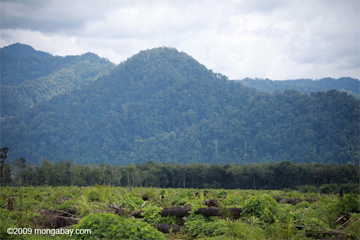Forests versus oil palm plantations in Sumatra
By Tomasz Johnson, special to mongabay.com A chainsaw chugs into life and tears into the trunk of a tree as tall as a two-storey house. Petrol and man work together as the chain sets its teeth into the wood and edges its way through. The tree creaks, leans, and falls with a great crash to a backdrop of whoops and cheers. The sight and sound of tree felling is common in Indonesia, the country with the highest rate of deforestation in the world. The destruction of forests in this archipelago, draped like an emerald necklace across the equator, can be measured in hectares per minute. Today, though, is a good day for the conservationists. The felled tree is an oil palm, or elaeis guineensis, the native of West Africa that has colonised millions of hectares of Southeast Asia’s formerly pristine forests. Its fruit is crushed, processed and bleached to form a flavourless, colourless oil. The invisible ingredient in everything from your chocolate to your shampoo. Here in Aceh, as elsewhere in Indonesia, oil palm is known as green gold, reaping vast profits for companies based across Asia and the West. Which makes cutting down palms at the height of their productive life very unusual indeed. … “I’ve seen people accept it and say ‘okay, people have moved in and planted trees, let’s redraw the boundaries,'” said Mike Griffiths, a native New Zealander who co-founded the Leuser International Foundation (LIF). “But you’ve got to fight it, to fight the tide of destruction.” …
